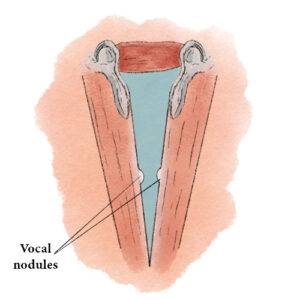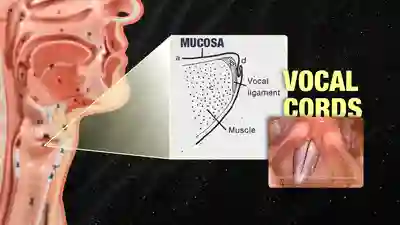Benign Vocal Cord Disorders Caused by Overuse/Vibratory Injury

Overview
A very high percentage of disorders that affect the voice can be termed benign mucosal disorders of overuse or vibratory injury. These injuries are almost always unintended. They occur in persons whose voice use (amount and manner) exceeds the ability of the mucosa to “keep up.” The result is tissue injury.
What Causes Vibratory Injuries?
The classic profile is the talkative and sociable individual whose lifestyle and occupation permits, invites, or requires extensive and sometimes vigorous voice use. One can summarize by saying this kind of person “spends a lot of vocal money.”
Less commonly, a vocal cord vibratory injury can occur as a “fluke” in a person who has a brief episode of extreme voice use—a “screaming argument,” sports event involving extreme voice use, etc.
How Are Vibratory Injuries Treated?
Where possible, vibratory injuries are allowed to heal by managing the amount, manner, and spacing of voice use to “spend less vocal money” for weeks or months while awaiting recovery. Some of these injuries may resolve with this conservative management; others may require surgery (if the patient is sufficiently motivated).
5 Classic Symptoms (e.g. from over-singing)
- Loss of high soft singing (what I call “boy soprano pianissimo”);
- Day-to-day variability of vocal capability; “Some days my voice isn’t too bad, and other days it is like I forgot how to sing.”
- Increased effort; “I can still sing but am aware I have to lean into my voice or even push a bit. Others may not notice and they still think I sing well, but I’m aware it is more work…”
- Reduced vocal endurance; This refers to reduced mucosal endurance. It takes less time for the mucosa to swell additionally. The singer often says “my voice is tired” when they really should say “my mucosa is a bit swollen.” Such a person may also say, “My friend and I sing the same choral rehearsal and at the end she is still fresh, but my voice is a bit husky.”
- Onset delays; This is heard only for soft singing (swelling checks). The person intends the voice to begin but there is a bit of air escape and then the voice pops in a moment later.
Share this article

5 Symptoms of Vocal Cord Mucosal Injury
Singers or others who have injured the mucosa—surface layer—of their vocal cords may have normal-sounding speaking voices and at the same time, singing voice frustrations.
This video explains the 5 most common symptoms of injury. In addition, Dr. Bastian’s prior video on vocal cord swelling checks can help the singer know when to begin thinking “my problem may be injury, and not acid reflux or a technical deficit.”
An Illustration of Vocal Cord Injury Prevention by Dr. Robert Bastian
When it comes to vocal cord injury, "It is better to build a fence at the top of a cliff than to park an ambulance at the bottom.” Prevention of injury is the point of Dr. Bastian’s tour of a cartoon he had drawn years ago.Vocal Money - Recovering from Vocal Cord Injury
Individuals who develop chronic vibratory injuries of the vocal cords, such as nodules and polyps, can be thought of as having been vocal overspenders.
And so, conceptualizing voice use as spending vocal money can provide a helpful analogy for those rehabilitating from their injuries. The idea is to think of having vocal money to spend every day, and to manage the amount, manner, and spacing of expenditure, in order to get out of the vocal debt of vibratory injury.